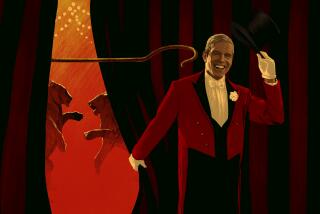Bravo Uses Edgier Fare to Attract Viewers
NEW YORK â A designer of âhumaneâ slaughterhouses. A journalist who hitchhikes cross-country. A pink Winnebago touring the Bible Belt, loaded with gay partyers.
Itâs hardly the kind of fare that the urbane, well-heeled viewers of Bravo expect from an arts-and-film network known for ballet, opera and foreign movies such as Mexicoâs hit âLike Water for Chocolate.â
But as the audience for cable TV expands and as the arena of cable channels trying to attract those viewers grows more crowded, networks have had to develop and adjust strategies.
In Bravoâs case, the strategy in recent years has been to add edgy content--such as the lifestyles of porn stars, televangelists and UFO chasers chronicled in âLouis Therouxâs Weird Weekendsâ--and to increase its number of commercials. In the past year, Bravo has seen its ratings rise, its overall audience increase and its revenues soar.
But such success comes at a price: Two years ago, Bravo ranked No. 1 in median household income of prime-time viewers, topping $58,000, ahead of even financial network CNBC in that key measure of how attractive a networkâs audience might be to advertisers, according to New York-based Mediamark Research Inc. Since then, Bravo has dropped a few notches, slipping below $54,000 and losing ground to cable networks ranging from Home & Garden TV to ESPN2 to CNN.
Executives at the 2-decade-old Bravo, which is based in Bethpage, N.Y., and is controlled by Cablevision Systems Corp., say they are not worried and that the income shift reflects the tricky balancing act that cable networks face.
While some broadcast and cable networks manage to build both big and clearly defined audiences, others shift too far and blur their identities.
âThat danger is always there,â said Bravo General Manager Ed Carroll, adding that the network still attracts one of the most sophisticated audiences of any network, especially one featuring entertainment rather than sports or news. âThe question is: How can we expand our niche to serve the broadest cross section of viewers but still be true to the niche? Thatâs the programming challenge we come back to every day.â
Carroll, who also oversees the Independent Film Channel, has been one of the chief architects of Bravoâs strategy in the past few years and has helped push the networkâs programming in the direction of more unconventional, edgy fare.
To further that effort, last month Josh Sapan, president of Bravo parent firm Rainbow Media, announced an alliance with Salon.com, under which the arts- and politics-focused Internet magazine will create a half-hour TV program for Bravo this year featuring some of its reporters and columnists.
In all, Bravo spent $33 million last year on programming--and will boost that figure by another 20% to nearly $40 million this year, one-third of which will be for original programming.
The amount of original programming has more than doubled, from 40 hours per week 18 months ago to more than 100 hours now, though ad industry executives say the network could still use a breakthrough hit.
Much of the money for original programming is coming from rapidly rising advertising revenue.
In September 1998, the network launched eight minutes of commercial breaks during each hour of films and programs, rather than just one minute between shows, as the network had done before.
More to Read
The biggest entertainment stories
Get our big stories about Hollywood, film, television, music, arts, culture and more right in your inbox as soon as they publish.
You may occasionally receive promotional content from the Los Angeles Times.










